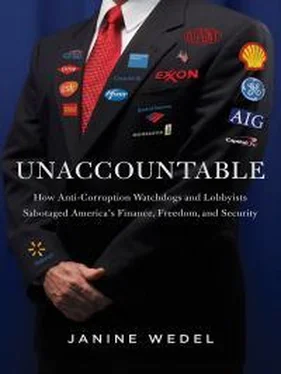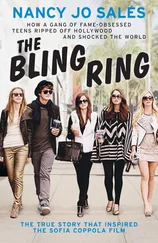Aside from emergencies, he made it clear that finance people often speak of a tradeoff between “efficiency” and “accountability.” The attitude is “We’re the experts; we don’t have the time.” Kapoor suggests there really are no outside perspectives because, quite simply, there are no outsiders: “Those who might have authority or information or wherewithal . . . are in one way or another a part of the system.” 36Indeed, if the players are assembling themselves informally, it’s not all that astonishing that they choose like-minded individuals with similar agendas not necessarily in the public interest.
Informal arrangements can be expedient and efficient. But accountability is almost inevitably sidelined, whether it’s in policymaking as seen in the financial bailout—or in what’s been dubbed the “sharing economy” emerging from Silicon Valley.
What about harm, liability, and risk when an Uber car crashes or an Airbnb house catches fire? 37The idea that all public problems have a desirable ad hoc private solution is, to say the least, reality-challenged.
Also reality-challenged is the hotly debated idea that more information unleashed by the digital revolution has made the world more transparent. Ironically, the control of information now seems weighted in favor of the entities and authorities (many of them corporate or private) that collect and use it for purposes mostly hidden from public view.
This can hardly inspire the public trust.
WE, THE COLLABORATORS
And yet, unsettling as this may be, I must raise this question: What about our own complicity? We may be the victims, but we are also collaborators. The first thing we do when signing on to a new computer system or program is to lie—that we have read all the legalese and caveats, and that we agree to them. But I would bet that very few people read the fine print (the companies monitoring our computers can probably tell us definitively), and those who do are seen as nerds or paranoids. We download and “agree” to the terms of use of software and such because we want to have them and realize that if we don’t click “agree,” we’re not going to get what we want. We disregard the privacy notice that comes with our credit-card bill and bank statement because, even though we know that information will be collected and used in ways we might not like, we need the credit card and the checking account.
Most of us play by these new informal rules because not doing so would relegate us to far more hassled—if not downright unworkable—lives. I can’t help but be reminded that likewise, to avoid marginal lives under the communism I witnessed, most people opted to skirt the broken formal system by fudging and finagling under the table to get what they needed. And while both cases involve deception, communist-schooled psyches are much more conscious of their own participation in this frequent practice. Should our not-quite-aware complicity in our own self-delusion concern us?
At the least, it should give us pause.
And so should the intermarriage of spies and Silicon Valley techies and what that portends. The communist experience is instructive. Communist publics were much more savvy than others about what happens to society when a massive machine is unleashed that can monitor and control people. Nearly everyone, at least under late Soviet and Eastern Bloc communism, knew full well that their systems were not designed to adequately fulfill citizens’ material needs and civic desires. Moreover, surveillance was in your face, subtlety nowhere in sight. When Romanians went to the authorities to register their typewriters each year, not only did they have no choice but to comply, but there could be no doubt that the purpose was to keep tabs on them. In that system, too, authority could be anonymous, but the intention was much clearer. (It is no accident that many of my Polish, Russian, and other eastern European acquaintances, recalling communism, have declined to join Facebook. They know all too well where the tools of such a surveillance bonanza can lead and how information gleaned from it can be used.) And today’s authorities don’t even have to steal our address books or strip-search or interrogate us directly; we willingly connect with our “friends” on Facebook, often divulging how we know them, along with myriad other details—and on a daily basis.
When core institutions are structured to be unaccountable and to flout the public trust, and when the trust between bureaucrat and client is broken, is this not a setup for pervasive violation of the public trust—the new corruption? And what are we to make of—and do about—the fact that, just as I witnessed under a communist system, we, the citizens, however powerless and in however small a way, are complicit in our own violation?
Our collaboration may be largely passive. It is nonetheless collaboration.
And have we not allowed ourselves to be seduced? As William White, again reflecting on what went wrong that led to the financial crisis, argues: 38
All of the parties who contributed to the crisis (borrowers, lenders, regulators, central banks, academics and politicians) were each seduced by various influences into believing different things that were not true. Moreover, since seduction normally involves more than one party, the relationships between these various parties also contributed to their having “no eye to see and no ear to hear.”

Do you recall what happened when I walked into a Bank of America branch, hoping my problem would be solved?
Nothing.
When the old means of restitution no longer work, and it is impossible to hold responsible parties to account, that is a sure sign that the system has moved on.
Just as many of us are defeated by the system at least some of the time, the most agile players among us know how to exploit it and take charge. We will see in the next chapter how some of those who do so violate our trust and fully engage in the new corruption.
CHAPTER 3
Inside the New Corruption
We are told this is an age of transparency. And yet the business of influencing appears to be getting less, not more, transparent.
Before we look at the world of influencing, though, let’s first consider a setting that is ultra-transparent. In the community of fewer than two thousand in which I grew up, the proverbial six degrees of separation are more like one or two. You can’t help but play multiple roles in a small town: a teenager babysits for her next-door neighbor’s kids whose father is also her schoolteacher and a colleague of her father’s and whose mother is also her Sunday school teacher. Is there potential for nepotism and corruption? Yes. But at the same time, everybody knows what everybody else is doing and it’s difficult to hide. In communities like this, agendas, roles, relationships, and sponsors are pretty clear.
When it comes to today’s top power brokers, this model is only partly accurate. Roles overlap and decisions get made with the same kind of small-town incestuousness—but, to the outside world, there’s little of the transparency of such a community.
Consider the examples of the following players who entered into a consequential policy debate affecting the global economy, airline security, and the American healthcare system, respectively. Each had information, along with experience and contacts, that they had amassed from their previous high-ranking roles in government or business—or, as is typical, both.
• Dan Jester, “retired” from Goldman Sachs, was brought in by Treasury Secretary and ex–Goldman Sachs chief Henry Paulson to assist in the 2008 financial bailout. He was hired as a “contractor,” not a government employee, and thus was not required to disclose his financial holdings and was subject to far fewer rules. The New York Times notes that Jester seemed “to have had his finger in every pie: rescuing Fannie Mae and Freddie Mac, the Lehman Brothers bankruptcy, the A.I.G. calamity, the decisions to bail out Citigroup, G.M. and Chrysler, and the creation of the Troubled Asset Relief Program. Jester also tried to negotiate deals for Lehman with both Bank of America and Barclays.” By all accounts, he served as Paulson’s de facto envoy in these high-stakes gatherings. 1
Читать дальше













